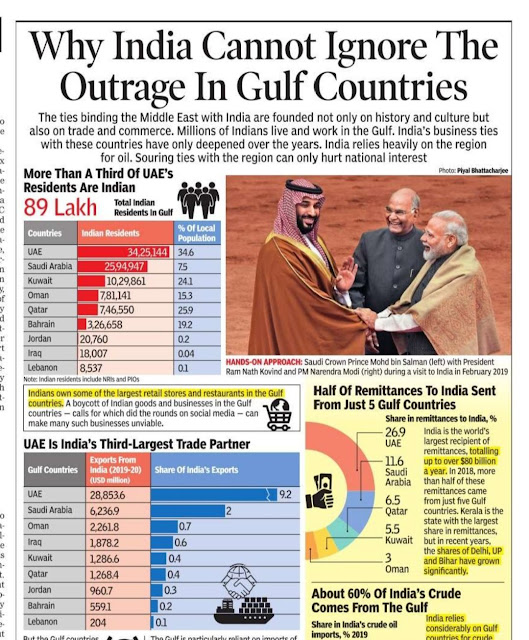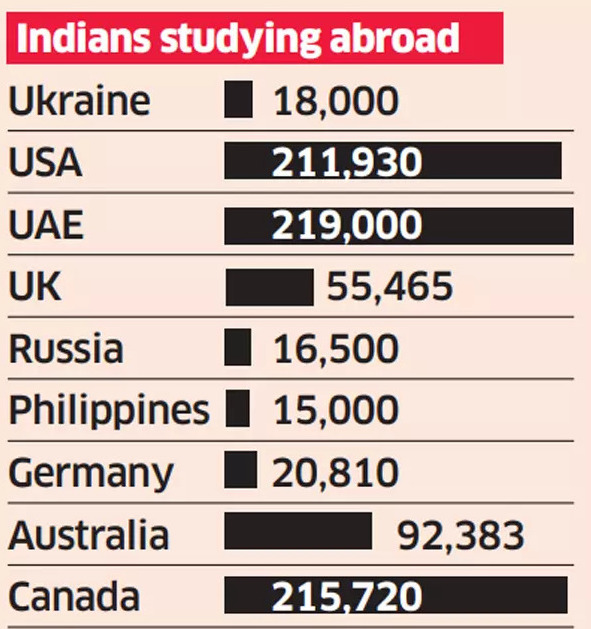
India's ties w ith the GCC nations - Source Advaid
Islamophobia: Can Modi's India Afford to Alienate the Entire Arab Muslim Middle East?
By Riaz Haq
CA

Recently, two official spokespersons of India's ruling BJP party insulted Prophet Muhammad (PBUH) on an Indian television channel known for promoting Islamophobia .
Mohammed Zubair (@zoo_bear), an Indian Muslim journalist, tweeted a video clip of the TimesNow show featuring BJP's official spokeswoman Nupur Sharma attacking the Prophet (SAW) revered by more than a billion Muslims around the world. As the video clip went viral, a long and growing list of Muslim countries has officially protested to the Indian government. The UAE, Oman, Indonesia, Malaysia, Iraq, the Maldives, Jordan, Libya, Bahrain and Pakistan have now joined Kuwait, Iran and Qatar, calling Indian ambassadors to register their protest, while Saudi Arabia has issued a strongly worded statement. "The Ministry of Foreign Affairs expressed its condemnation and denunciation of the statements made by the spokeswoman of the BJP,” the Saudi statement said.The BJP's entire domestic politics is built on the hatred of Islam and Muslims. At the same time, Prime Minister Narendra Modi, who many hold primarily responsible for promoting Islamophobia in India, wants to have strong economic ties with the Arab Muslim Gulf states. This latest crisis has exposed the built-in contradictions in the BJP's domestic and international agenda. It is important to note that nearly 9 million Indians work in the Arab Gulf nations, 60% India's crude oil comes from the Middle East and the UAE is India's third largest trading partner. Half of all remittances to India (nearly $40 billion) come from just five Gulf nations of the GCC.
The Hindu Nationalists led by Prime Minister Modi are particularly hostile toward Muslims but also other Abrahamic faiths and the West. American journalist Walter Russell Mead described this trend in a recent Wall Street Journal Op Ed as follows: "Many BJP supporters want the Indian government to defend India’s Hindu civilization and culture from Islam, Christianity and Western secular liberalism. This form of Hindu nationalism leads to controversial policy initiatives".
The fact that the United Arab Emirates has joined the protest is particularly significant. The Arab Muslim UAE, a grouping of seven Arab Muslim kingdoms, has now become the number one destination for education and employment of people from India, according to the government data from the two countries.
India is now ruled by the right-wing Hindu BJP party headed by Prime Minister Narendra Modi whose entire politics is based on extreme hatred of Islam and Muslims . In 2020, Emirati Princess Sheikha Hend bint Faisal al-Qasimi strongly criticized Islamophobia in India . She also expressed solidarity and sympathies with Indian Muslims and Kashmiris.

Indians students abroad - Source Economic Times
Over 1.2 million Indian students are now studying overseas, twice more than a decade ago. The UAE has 219,000 Indian students, Canada 215,720, the US 211,930, Australia 92,383, Saudi Arabia 80,800, Britain 55,465, and Oman 43,600, according to the data released by India's Ministry of External Affairs.
Besides students, there are millions of foreigners working in the UAE . Currently, the Indian population in UAE is the highest aggregating 2.75 million, followed by Pakistanis with 1.27 million. The UAE has around 0.75 million Bangladeshi nationals, 0.56 million Filipinos, and 0.48 million Iranians. There are also people from Egypt (0.42 million), Nepal (0.32 million), Sri Lanka (0.32 million), China (0.21 million) and the rest of the world (1.79million).
Last year, India received $43 billion in remittances from the UAE. Total worker remittances to India reached $87 billion last fiscal year, making it the world's largest recipient of remittances.
The United States was the second largest destination for Indian students . China maintained its top position among the leading places of origin for international students, with 35% of all international students in the 2020-21 school year hailing from the country, according to data released by the United States government. The second most common place of origin was India (18%), followed by South Korea (4%) and Canada (3%). Some of these countries also experienced the largest year-over-year declines in the number of students who enrolled at US institutions. The largest percentage decreases occurred in South Korea (-21%), China (-15%) and India (-13%).
(Riaz Haq is a Silicon Valley-based Pakistani-American analyst and writer. He blogs at www.riazhaq.com )

